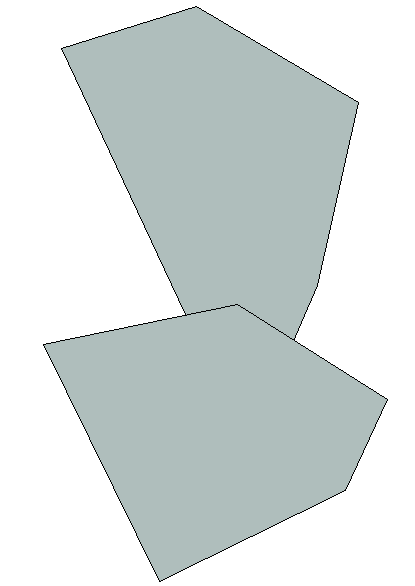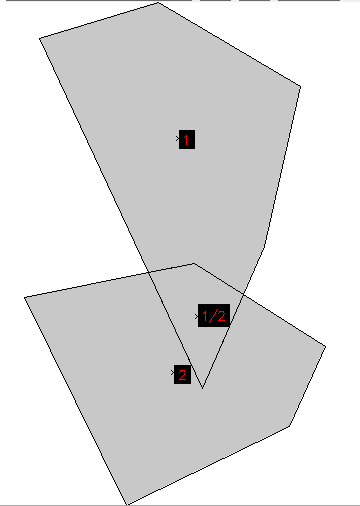Vector topology cleaning: Difference between revisions
(+If the input polygons have logical errors...) |
(more hints from ML added) |
||
| Line 42: | Line 42: | ||
'''Q:''' How about self-intersecting lines and boundaries? | '''Q:''' How about self-intersecting lines and boundaries? | ||
'''A:''' In the GRASS topological model self-intersecting lines are allowed, self-intersecting boundaries are not. Self-intersecting lines are ok e.g. for {{cmd|v.net}} modules, e.g. to represent a bridge of a secondary road over a highway. | '''A:''' In the GRASS GIS topological model self-intersecting lines are allowed, self-intersecting boundaries are not. Self-intersecting lines are ok e.g. for {{cmd|v.net}} modules, e.g. to represent a bridge of a secondary road over a highway. | ||
Note: There are some modules that do not like self-intersecting lines, e.g with {{cmd|v.buffer}} problems are expected. | Note: There are some modules that do not like self-intersecting lines, e.g with {{cmd|v.buffer}} problems are expected. | ||
'''Q:''' I've imported a shapefile with 6842 input polygons and after importing (with 1e-12 snapping threshold) there are 6800 centroids. Further cleaning does not change the topology. Why? | |||
'''A:''' It could be that some of the input polygons are exact duplicates. v.clean can remove them. | |||
'''Q:''' Can I ignore the areas without centroids? | |||
'''A:''' Yes, these are typically holes in polygons (islands). | |||
== See also == | == See also == | ||
Revision as of 20:52, 11 May 2013
Cleaning large network datasets
Q: How can I speed up topologial cleaning (v.clean) in GRASS 6 for large network datasets (for example OpenStreetMap data)?
A: The improved v.clean version in GRASS 7 is way faster. Here some hints though:
GRASS 6: When breaking lines it is recommended to
- split the lines first in smaller segments with v.split using the vertices option. Then,
- run v.clean with 'tool=break'. After that,
- use v.build.polylines to merge lines again.
GRASS 7: Here this has become much easier. Use v.clean with the -c flag and 'tool=break' and 'type=line'. The 'rmdupl' tool is then automatically added, and the splitting and merging is done internally.
Cleaning patched polygons
Q: How can I patch to fitting area maps with have been digitized separately and correct the topology? I observe that the shared polygon boundaries do not perfectly match... I need to clean topology.

A: You can use v.clean for this.
Tools to consider:
- snap,bpol,rmdupl,break,rmdupl,rms
- the threshold (in map units) should be very small
Example (Lat-Long):
v.in.ogr natural_earth/ne_110m_admin_0_countries.shp out=country_boundaries snap=0.0001 TODO: FIX THIS
Polygon import from SHAPE file

v.clean applied:

Hints
- In recent GRASS GIS versions, snapping thresholds for unclean polygons are suggested to the user when using v.in.ogr
- If the input polygons are supposed to not overlap each other, the number of centroids should be identical to the number of input polygons. If not the case, more topological cleaning is needed.
- If the input polygons have logical errors, for example when the same landuse polygon is present more than once, this can not be cleaned automatically with v.in.ogr or v.clean. You can investigate overlapping areas in the imported vector with 'd.vect type=area layer=2' (only overlapping areas have a category in layer 2 after import).
Q: How about self-intersecting lines and boundaries?
A: In the GRASS GIS topological model self-intersecting lines are allowed, self-intersecting boundaries are not. Self-intersecting lines are ok e.g. for v.net modules, e.g. to represent a bridge of a secondary road over a highway.
Note: There are some modules that do not like self-intersecting lines, e.g with v.buffer problems are expected.
Q: I've imported a shapefile with 6842 input polygons and after importing (with 1e-12 snapping threshold) there are 6800 centroids. Further cleaning does not change the topology. Why?
A: It could be that some of the input polygons are exact duplicates. v.clean can remove them.
Q: Can I ignore the areas without centroids?
A: Yes, these are typically holes in polygons (islands).
See also
- Vector topology
- Topology examples (GRASS Programmer's Manual)